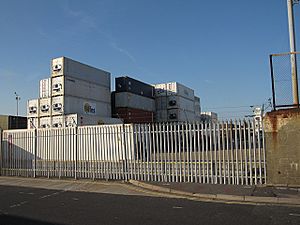Fyffes facts for kids
 |
|
| Private | |
| Industry | Produce |
| Founded | 1888 in London, United Kingdom |
| Founder | Edward Wathen Fyffe |
| Headquarters |
Geneva
,
Switzerland
|
|
Key people
|
Helge H. Sparsø
CEO
|
| Products | Fruit: bananas, melons, pineapples, |
| Revenue | €1.09 billion (2014) |
|
Operating income
|
€38.8 million (2014) |
| €34.1 million (2014) | |
| Owner | Sumitomo Group (Japan) |
Fyffes plc is a company famous for selling fresh fruit. When you see the Fyffes blue sticker on a banana, you know it's from them! While they are best known for bananas, they also sell other fruits like Fyffes Gold Pineapples and different kinds of melons.
The company gets fruit from farms, ships it across the world, and makes sure it's perfectly ripe when it gets to the store. Fyffes sells its fruit in Europe and North America under the brand names Fyffes and Turbana.
Contents
The Story of Fyffes
The history of Fyffes is a long journey that started with one man and a new idea. Over the years, the company grew, faced challenges, and became one of the most recognized fruit brands in the world.
How It All Began
Back in 1888, a food seller in London named Edward Fyffe started bringing bananas to the United Kingdom. At the time, bananas were a rare and exotic fruit for most people. His idea was a big hit!
In 1897, he joined his business with another company, Hudson Brothers, to create Fyffe Hudson & Co. They were so successful that they bought land in the Canary Islands to grow their own bananas.
Another big shipping company, Elder Dempster & Company, saw how well Fyffe's business was doing and decided to get into the fruit business too. In 1901, the two companies merged to become Elders & Fyffes Ltd. A year later, the famous United Fruit Company from America bought a large part of the new company. They used special ships with cooling systems to keep the fruit fresh during the long trip across the Atlantic Ocean.
New Ideas and Big Changes
Fyffes has always been interested in new technology. In 1960, they tested a special vehicle called a Cushioncraft, which is a type of hovercraft. They wanted to see if it could be used to move bananas easily on their farms.
In 1969, the company changed its name to Fyffes Group Ltd. Then, in 1986, an Irish company called FII plc bought Fyffes, and it became an Irish company. By 1989, it was known simply as Fyffes plc.
Challenges and Helping Others
In the 1990s, Fyffes had a major disagreement with the company Chiquita over the supply of bananas from Honduras. The two companies argued for years, but the issues were finally settled in 2001 when new rules for importing bananas into Europe were created.
In 2004, a Fyffes banana ship helped rescue four sailors whose boat was destroyed in a storm off the coast of Ireland. The ship was on its way from Costa Rica with a huge load of bananas when it answered the call for help.
In 2008, Fyffes partnered with UNICEF Ireland. For five years, they helped fund UNICEF's work in Mozambique to protect children from the disease malaria.
Recent History
- 2014: Fyffes and Chiquita planned to join together to create the world's biggest banana company. However, the plan was called off later that year.
- 2015: The company stopped buying bananas from a large farm in Belize. This was because of concerns that the farm had connections to people involved in illegal activities.
- 2016: Fyffes expanded its business by buying two mushroom-growing companies in Canada.
- 2017: The Japanese company Sumitomo bought Fyffes, and it became a private company.
- 2020: Fyffes decided to focus mainly on fruit and sold its mushroom business.
What Fyffes Does Today
The Fyffes blue label first appeared on bananas in 1929 and is still used today. Besides bananas and pineapples, Fyffes imports many types of melons. These include Galia, cantaloupe, and watermelon. The fruit comes from countries like Brazil, Honduras, Guatemala, and Costa Rica.
To make sure bananas are ready to eat, they are placed in special "ripening rooms." The Fyffes ripening center in Basingstoke, England, is the largest in Europe. It can hold over 2,100 tonnes of bananas at one time! In the past, the company even had its own fleet of ships called Fyffes Line.
See also
- List of Irish companies


